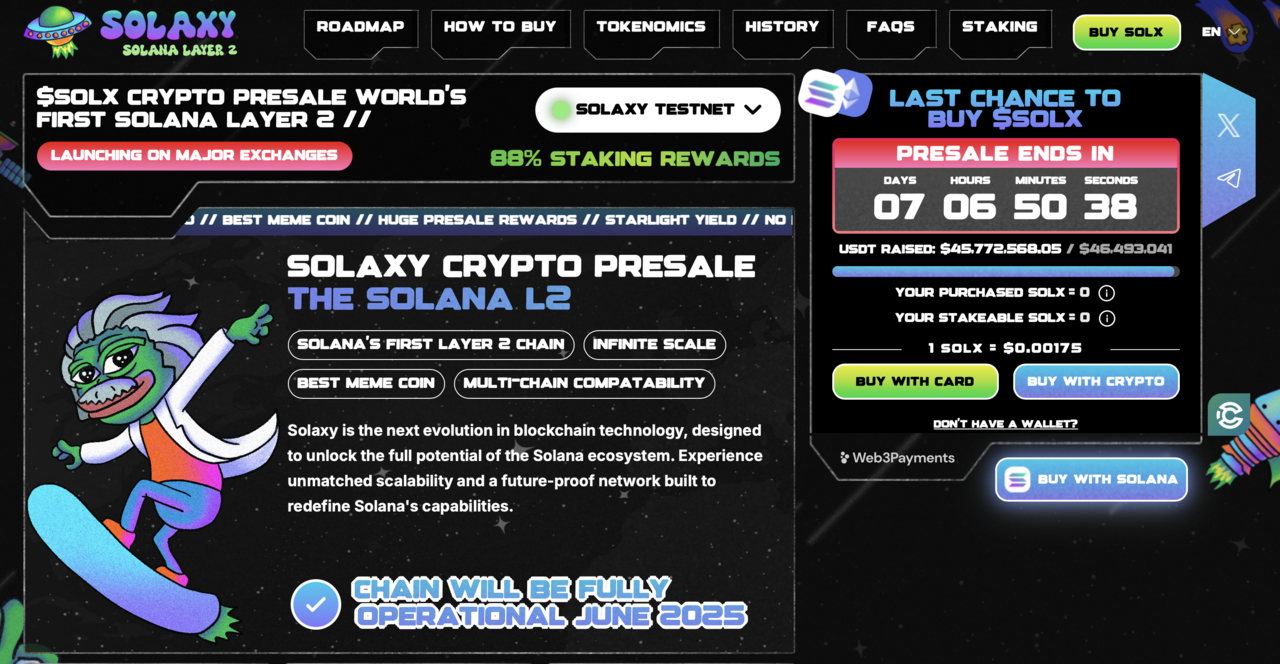Solaxy Presale Enters Final Week With $45 Million Raise: Best Altcoin to Buy?
09.06.2025 12:27 6 min. read Nikolay KolevWe may earn commissions from affiliate links or include sponsored content, clearly labeled as such. These partnerships do not influence our editorial independence or the accuracy of our reporting. By continuing to use the site you agree to our terms and conditions and privacy policy.

In a move that could set the stage for Solana’s biggest scalability breakthrough, Solaxy (SOLX) has entered the final week of its presale. The project has already attracted widespread attention by raising $45.8 million, making it one of the year’s most talked-about crypto launches. This milestone coincides with Bitcoin’s (BTC) healthy recovery above $105,000 after the top crypto briefly dipped on Thursday, while Solana (SOL) bulls are working hard to keep their favorite coin’s price above $150.
Solaxy is Solana’s first true Layer 2 solution, arriving at a crucial moment as Solana ramps up major upgrades (like Alpenglow and Firedancer) to address issues like congestion and occasional outages.
Meme coins, new dApps, and DeFi users have historically flocked to Solana for its speed and low fees. At the same time, these surges in network activity have exposed a growing need for scalable solutions. Solaxy will step in to resolve congestion by offloading transactions onto a rollup-inspired sidechain, improving throughput while keeping Solana’s security intact.
Early buyers have just seven days left to purchase SOLX at its presale price of $0.00175 before it’s listed on exchanges. With the final countdown ticking, investors see Solaxy as a potential anchor for Solana’s evolving ecosystem that could reward early movers after its mainnet launch.
This publication is sponsored. CryptoDnes does not endorse and is not responsible for the content, accuracy, quality, advertising, products or other materials on this page.
As Solana Upgrades for Speed and Scale, Solaxy Offers Immediate Layer 2 Relief
Solana’s competitive edge has always involved high speed and low costs, and it’s now sharpening that edge further with a series of transformative upgrades. One key addition is the recent Alpenglow consensus protocol, which uses a new mechanism called “Votor” for on-chain voting and another called “Rotor” to take care of data dissemination. These new components are generally expected to cut Solana’s network latency by up to 100x without creating excessive hardware requirements.
In tandem with Alpenglow, Solana’s ZK Compression v2 scaling update could radically change the platform’s on-chain economics. If it works as anticipated, developers will be able to build more complex applications on-chain without paying sky-high gas fees. Storage efficiency could also be improved by around 70%, while gas costs would be reduced by 1,000x.
Developers are also progressing on other significant upgrades, like the Firedancer validator client, which aims to push transaction finality closer to real-time. This is designed to maintain Layer 1 security and composability, ensuring that these improvements don’t compromise Solana’s core strengths.

Solana’s reputation has inspired heavyweight alliances – such as a new partnership between Amber International and DeFi Development Corp, which will bring traditional finance clients into Solana-based markets. However, strong institutional interest also raises the challenge of handling a flood of transactions without Solana slowing down or crashing.
Major meme coin launch events (such as the introduction of Donald Trump’s official meme coin) and NFT mints have tested Solana’s limits, leading to congestion and a few brief outages. That’s where the concept of Layer 2 scaling becomes critical. Ethereum offers a strong case study, as popular L2s like Arbitrum and Optimism both handle a significant portion of the main chain’s activity – thereby easing its overall load.
Solana is just now catching up as Solaxy arrives to close this gap. By adding an extra layer on top of Solana’s base chain, it aims to keep fees negligible and transaction speeds blazing even under heavy traffic burdens.
Solaxy Delivers Real Layer 2 Scaling for Solana With Live Testnet
Solaxy’s Layer 2 approach is rollup-based: most transactions take place on Solaxy’s sidechain, with batches periodically posted to Solana’s mainnet for final security.
Let’s say you’re launching a new dApp that handles thousands of user actions per minute. Instead of dumping all those transactions onto the main Solana chain (risking network slowdowns), your project can run them on the Solaxy sidechain. Meanwhile, Solana still confirms and secures those transactions – ensuring the entire system remains decentralized and safe.
On June 2, Solaxy’s team offered developers a first-hand look at the project’s core architecture. By connecting a compatible Solana wallet to the Solaxy testnet, users can bridge SOL from Solana’s devnet to Solaxy, test smart contracts, and experiment with basic transactions. A dedicated Solaxy block explorer lets users watch these processes in real time.
🚨 Hey Solaxy Community it’s here.
The Solaxy Testnet is LIVE. Your first chance to interact with Solana’s first Layer 2 and experience the speed, scale, and simplicity Solaxy brings. 🔥⚡️
🔗 Connect via Backpack Wallet:https://t.co/FBrV3FohC8
You can:
– Bridge SOL (Solana… pic.twitter.com/FQY9AIwSdx— SOLAXY (@SOLAXYTOKEN) June 2, 2025
Beyond scaling, the project is adding other features to streamline development. For example, the Igniter Protocol launchpad will make it quick and easy for anyone to create and deploy new tokens on Solaxy, and have them automatically listed on an integrated DEX. This launchpad-to-DEX model could spark rapid growth for meme coins, NFTs, and any other project that needs a frictionless launch process.
Moreover, Solaxy plans to keep its platform developer-friendly by mirroring Solana’s standard toolchain. Existing Solana dApps won’t need a major code overhaul, as they can port over without rewriting everything from scratch.
Solaxy Enters Final Presale Week With Massive Investor Demand
The record-setting $45.8 million raised by the SOLX presale reflects industry-wide confidence that Solaxy could become a central part of Solana’s scaling story. Just look at Ethereum’s scaling scene: solutions like Polygon, Arbitrum, and Optimism grew rapidly because they solved a pressing need for faster and cheaper transactions. Their associated tokens (MATIC/POL, ARB, and OP) also soared to multi-billion-dollar market caps, rewarding early adopters in the process.
With its high throughput and rising developer activity, Solana has lacked a similar sidechain or rollup solution – and Solaxy is now seizing that open spot. Its first-mover advantage could place SOLX at the forefront of a market that’s hungry for leading solutions that keep Solana agile while usage grows.

As the SOLX presale hits its final phase, the official countdown clock shows just seven days remaining. When it reaches zero, the SOLX price could swiftly rise after the coin gets listed on exchanges – so presale participants will have a head start. Per the Solaxy roadmap, a token generation event (TGE) will take place immediately after the sale ends, and tokens will be distributed to presale buyers. From there, all eyes will turn to SOLX exchange listings and Solaxy’s full Layer 2 launch.
Many investors (especially whales) aren’t waiting for listing announcements to come before putting their SOLX to work. Over 13 billion SOLX tokens have already been staked for APYs of 88% or more, providing a quick and easy way for holders to passively grow their portfolios.
This publication is sponsored. CryptoDnes does not endorse and is not responsible for the content, accuracy, quality, advertising, products or other materials on this page. Readers should do their own research before taking any action related to cryptocurrencies. CryptoDnes shall not be liable, directly or indirectly, for any damage or loss caused or alleged to be caused by or in connection with use of or reliance on any content, goods or services mentioned.
-
1
Best Crypto to Buy: SPX6900 Registers 294% Gain in Q2, TOKEN6900 to Explode Next in Q3?
16.07.2025 14:13 5 min. read -
2
Ethereum Price Prediction: ETH Soars 20% as Bitcoin Dominance Drops, Can Ethereum Hit $4,000 in Altcoin Season?
16.07.2025 14:46 4 min. read -
3
Best Crypto to Buy Now as Capitol Hill Ignites a High-Stakes Crypto Showdown
14.07.2025 1:26 7 min. read -
4
Ethereum Price Prediction: ETH to Could Soar to $3.5K as Trading Volumes Hit $33.7B
15.07.2025 0:45 4 min. read -
5
Best Wallet Token Raises $13.8 Million in Viral Presale – Next Big Crypto Wallet Token?
13.07.2025 12:46 4 min. read
ChatGPT Predicts the Price of XRP, Solana, and Dogecoin by End of 2025
The crypto market has been on fire over the past week, and XRP, Solana, and Dogecoin have been among the top gainers. XRP hit a new high of $3.6, Solana is nearing $200, while Dogecoin is up 38% in seven days. But how far could these coins go in the current cycle? We decided to […]
As Cardano and XRP Soar, This New Meme Coin Could be the Best Crypto to Buy Now
Following Bitcoin’s all-time high of $123,000, the crypto market is heating up again. Among the top gainers, Cardano (ADA) jumped over 17% in the last seven days, while XRP surged by over 22%, setting a record high above $3.6. Alongside the major alts, meme coins are also catching fire again. Dogecoin has risen 38% in […]
Best Crypto to Buy Now? Rich Dad Poor Dad Author Robert Kiyosaki’s Bitcoin Price Prediction
When Robert Kiyosaki, a name synonymous with bold financial advice, revealed his precise rules for adding Bitcoin to his portfolio, the crypto community sat up and took notice. He pledged to scoop up more BTC once prices cleared $117,000, only to slam the brakes when Bitcoin rocketed past $120,000 and hit fresh all-time highs. YAY: […]
Bitcoin vs Ethereum: ChatGPT Reveals the Best Crypto to Buy in the Bull Run
It’s been an incredible week for crypto investors – Bitcoin hit a new all-time high while Ethereum rallied past $3,600, sparking debate regarding which of the top two cryptocurrencies could give the biggest gains going forward. To try to answer this question, we decided to ask ChatGPT whether Bitcoin or Ethereum are the best crypto […]
-
1
Best Crypto to Buy: SPX6900 Registers 294% Gain in Q2, TOKEN6900 to Explode Next in Q3?
16.07.2025 14:13 5 min. read -
2
Ethereum Price Prediction: ETH Soars 20% as Bitcoin Dominance Drops, Can Ethereum Hit $4,000 in Altcoin Season?
16.07.2025 14:46 4 min. read -
3
Best Crypto to Buy Now as Capitol Hill Ignites a High-Stakes Crypto Showdown
14.07.2025 1:26 7 min. read -
4
Ethereum Price Prediction: ETH to Could Soar to $3.5K as Trading Volumes Hit $33.7B
15.07.2025 0:45 4 min. read -
5
Best Wallet Token Raises $13.8 Million in Viral Presale – Next Big Crypto Wallet Token?
13.07.2025 12:46 4 min. read

